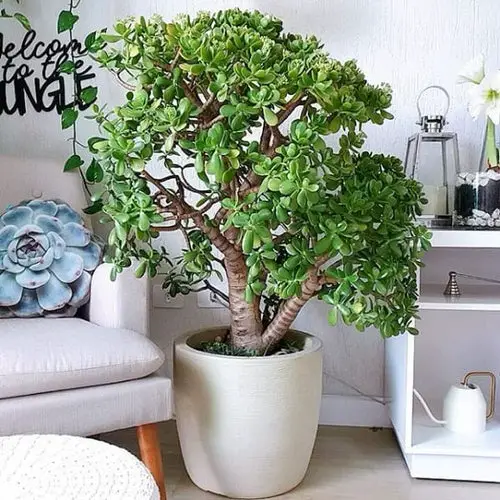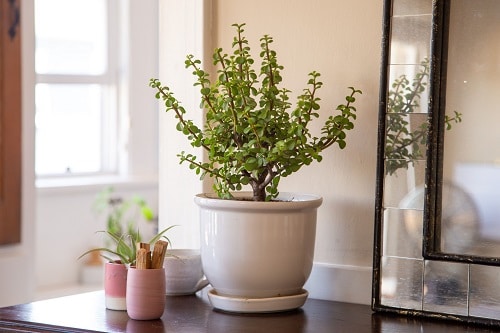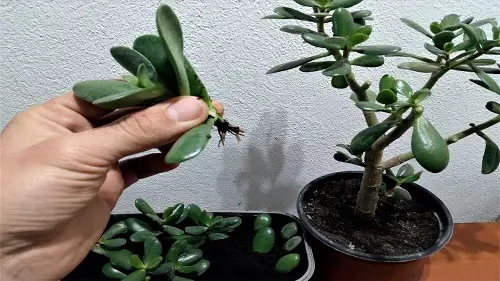Jade Plant Care and Growing Indoors is not difficult if you know all its requirements. It’s one of the best low-maintenance succulent houseplants you’ll ever grow.

Jade is a famous houseplant with fleshy oval-shaped glossy green leaves and thick woody stems. It is believed that the jade plant brings good luck and prosperity, making it more popular in homes as a houseplant. If you have one in your home, then here’s everything you need to know about Jade Plant Care!
Botanical Name: Crassula ovata
USDA Zone: 10-11, can be grown indoors in all climates
Common Names: Jade Plant, Money Plant, Dollar Plant, Friendship Plant
Check out our article on Jade Plant benefits here
Types of Jade Plants

Apart from the common jade plant (Crassula ovata), you can also grow its other types as well:
- Tolkien Jade Group
- Lady Fingers Jade
- Hummel’s Sunset
- Pink Jade Plant
- Baby Jade Plant
To learn more about these popular Jade Plant Varieties, click here
Propagation and Pot Size

Jade plant is super easy to propagate, and you can grow it from a leaf cutting.
- Take healthy leaves from a mature plant, twisting and rotating them gently by hand without damaging any.
- Let the leaves callus for 4-4 days.
- Once done, lay the leaves over a shallow tray filled with light soil mix.
- Rest all the process is similar to growing any succulent from leaves, which you can find here.
You can also grow a jade plant from a stem cutting. Simply cut the 4 to 6 inches long stem from the plant and put it in a pot. For more information on succulent propagation, click here.
Best Pot Size for Jade Plant
As it’s a slow-growing plant, you can start a small and young plant in a 4 to 6 inches pot. The size of the pot should be in a way that it keeps the plant slightly root bound, and then re-pot it in one size bigger pot once the plant outgrows your current container.
Again, it’ll grow fast if you’ll keep it in a slightly root-bound state, which you can do by avoiding planting it in a very large container.
Requirements for Growing Jade Plant Indoors

Location
Keep this drought-tolerant plant in a bright shade in your home. A spot in your room that gets indirect light is the best place. And your jade plant will love it if the space receives direct sun in the morning or evening.
Note: To prevent leaf scorching, don’t expose your indoor jade to the full sun suddenly without acclimatization.
Soil
It must be well-draining as excessive moisture leads to rot. Use a succulent or cactus mix with slightly acidic to neutral pH–you can also mix some perlite, coconut coir, or styrofoam balls in it.
If you’re using a regular potting mix, make a combination of two parts soil, one part coarse sand, and one part perlite with some bone meal to make it more potent.
Watering
Watering your indoor jade plant is not complicated but tricky. It should never be too much and never too little. Always water thoroughly but wait until the soil becomes dry before watering.
Don’t grow this succulent in moist soil and avoid overhead watering; you’ll be safe if you keep it on the drier side rather than watering it frequently.
During winter and wet weather, be extra cautious and reduce watering. The plant will show blisters on its leaves if overwatered. If you notice them appearing, it’s time to cut down on watering.
If you notice shriveled, small, and dry leaves of the jade plant, this can be due to underwatering. This shows your plant is asking for a good dose of water!
Jade Plant Care
Fertilizer
Your jade plant will do just fine even if you won’t fertilize it unless you see the need. This succulent doesn’t need a fixed fertilizing schedule like other houseplants.
Just feed it once in 20-60 days during the active growth period with your regular all-purpose liquid fertilizer (like 20-20-20 or 10-20-10) diluted to 1/4 (25%) of its recommended strength.
Note: Stop fertilizing from mid-fall up to winter if you live in a cold climate.
Pruning
The plant is not an aggressive grower, so you don’t have to prune it regularly to keep in shape. Just snip away dying or shriveled branches and leaves from time to time. This will keep the plant healthy.
Pests and Diseases
Be careful about spider mites and scales. Using a strong jet of water or an insecticidal soap solution will take care of them. In diseases, you have to watch out for powdery mildew and black ring disease. Remove the affected parts of the plant quickly using a sharp shear.
Jade Plant Winter Care
- Move your plant away if it’s touching the windowpane or from the spot where it could be exposed to the cold drafts.
- One more thing to keep in mind if you live in a temperate region is jade plant’s growth slows down in winter, so you don’t have to water it much often.
- Keep this plant in a warm indoor room in winter, as a temperature below 40 F (5 C) is harmful to this succulent.



One of my jade plants put forth small white flowers last year.
This Dec the jade that sat next to it during outdoor summer camp, now has blossoms.
No one else has ever seen a jade bloom…one individual said stress made it bloom. Your input?
I also have had a snake plant bloom at the end of summer. Small white flowers on a stem.
My jade blooms every year.
Very helpful. I have learned a lot on growing Jade plants. Thank you
Thank you for all the information growing Jade plants. I learned a lot of helpful information! Thank you